V60 Recipe (Advanced 4:6 Method)
Sweet and elegant. Enjoy a juicy brew that stimulates your salivary glands!
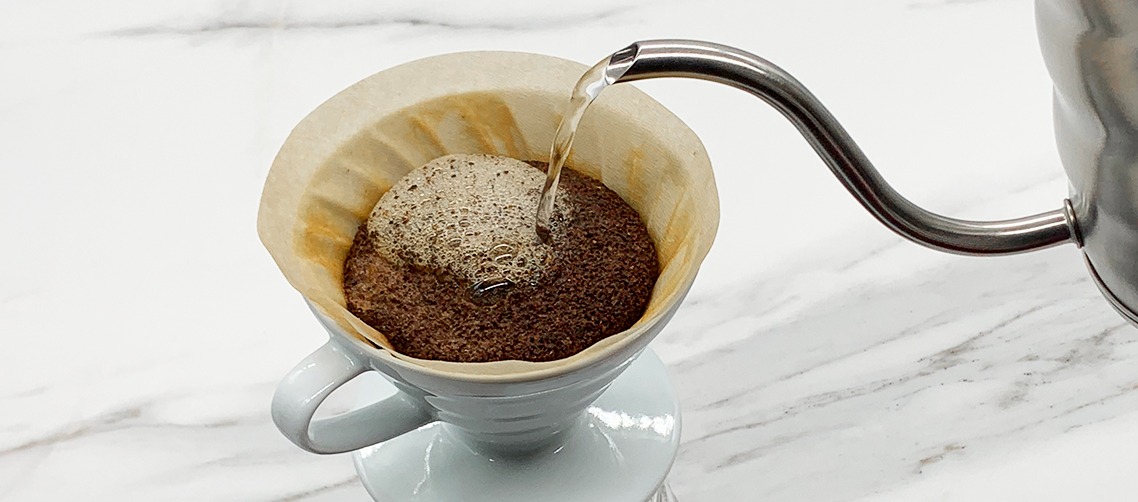
The story behind the best V60 recipe
Featuring Tetsu Kasuya’s winning coffee recipe in World Brewers Cup 2016 — the best V60 coffee recipes in the world! Using the versatile 4:6 method with a TDS aim of 1.30, this recipe highlights all the sweetness and fruitiness in the coffee beans to give you a clear, juicy cup. Take a sip and you’ll understand why this perfect brewing method has captured the hearts of coffee lovers around the world.
Brew your sweet V60 coffee
Ingredients
- Brew Time: 3 min 30 sec
- Serving: 3 - 4 cups
- Hot water: 600ml (to brew) + 100ml (to preheat apparatus and rinse paper filter)
Toys you need
- Your favourite coffee cup(s)
- 1 small bowl
V60 recipe tips
- Adjust serving as desired, at coffee to water ratio of 1:15.
- Use coarse grind size. We recommend the following grind sizes:
- 6.5 to 7 notches for Hario Skerton +
- 19 to 21 for Baratza Encore
- For filter roast, brew with hot water just off the boil (94°C and above). On the other hand, for espresso roast, allow hot water to cool for 3 to 5 mins (88°C – 92°C) before brewing.
- Observe your coffee bed at the end of the brew. A flat coffee bed suggests an even extraction.
In this V60 recipe, we have adapted Tetsu Kasuya’s 4:6 method to yield 3-4 cups of sweet coffee, as we feel it is more optimal with a size 02 brewer.
To yield 1-2 cups, divide the ingredients by 2. Brewing and pouring time remains the same. You can also refer to our V60 4:6 method recipe video for 1-2 cups.
4:6 Method: Adjusting sweetness, acidity and strength
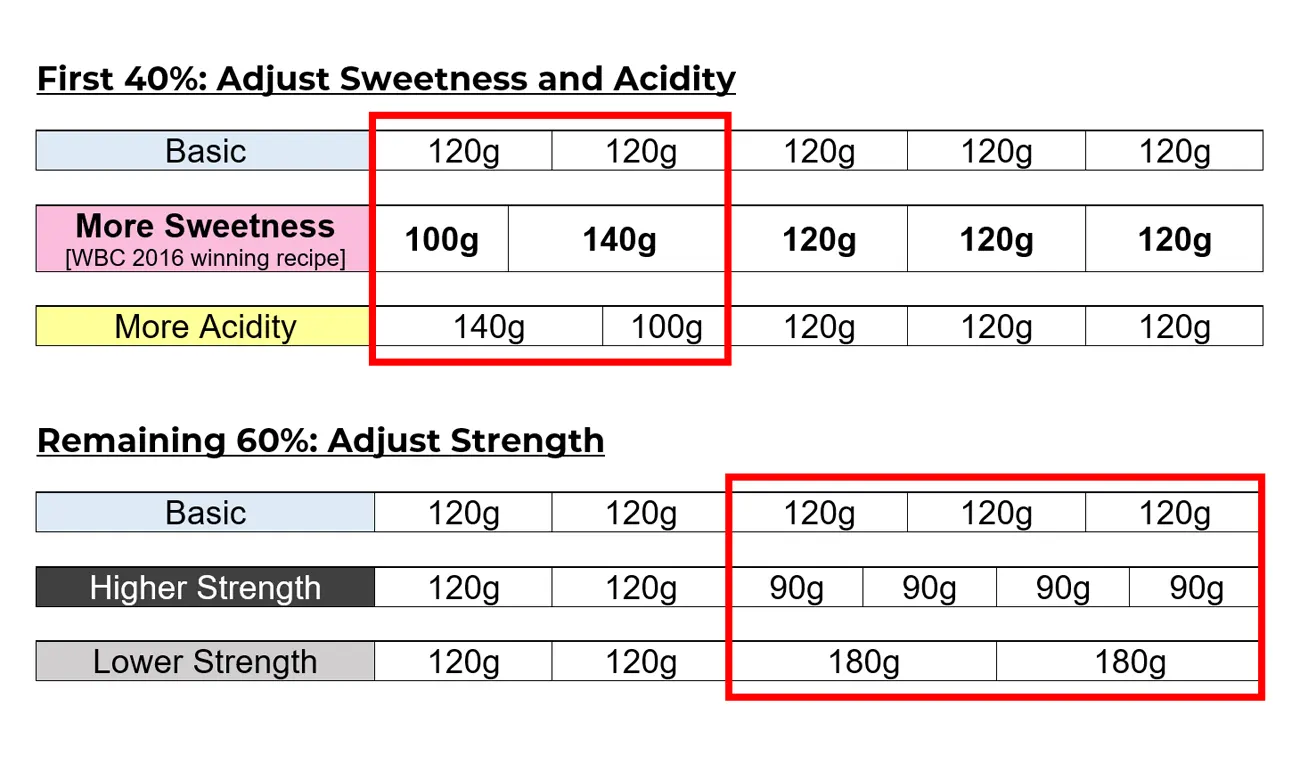
In this step by step guide, we will be using the World Brewers Cup 2016 winning recipe that highlights more sweetness in your coffee.
However, you can adjust the sweetness, acidity and strength to your liking by referencing the above table.
How to play
Step 1
Bring water to boil using the Drip Kettle or boil enough water to fill the Drip Kettle. While the water is heating, insert paper filter into V60. Then, grind 40g of coffee.
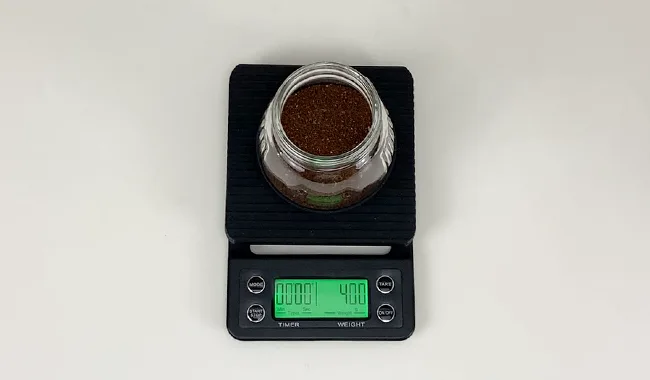
Step 2
Set V60 on top of the Range Server. Rinse paper filter adequately with hot water. After that, empty the Range Server.
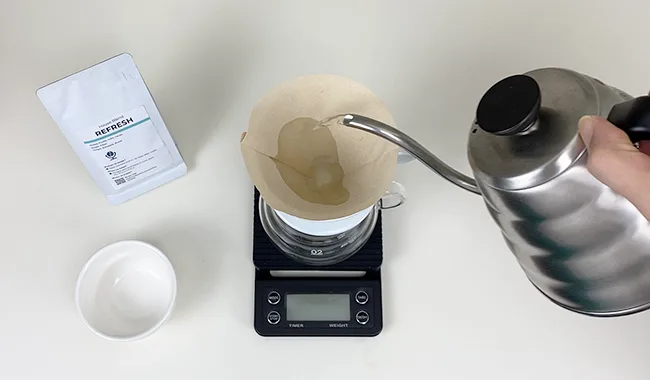
Step 3
Add 40g of coffee grounds into V60. Wiggle to level the coffee grounds. Then, tare the scale.

Step 4
Start timer. Pour 100g of hot water in a continuous circular motion, moving from the centre point into a wider circle and then back to the centre point. Complete this pour in 10 seconds, then pause.
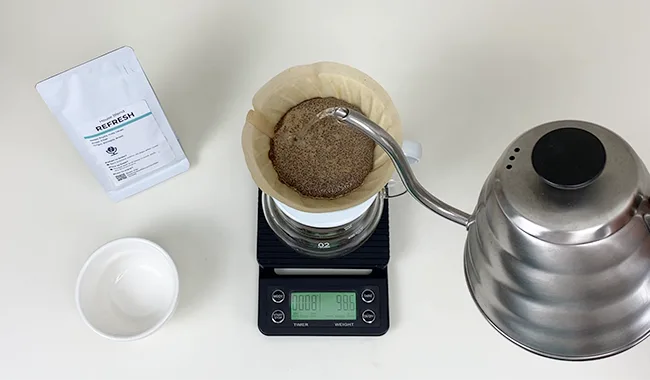
Step 5
Pour another 4 times at intervals of 45 seconds. To highlight the sweetness of your coffee, refer to the following brewing phases for the amount of each pour:
Brewing Phases (Advanced 4:6 Method – Sweet)
5 Pours for Balanced Strength
| Time | Coffee Scale Reading | Water Amount to Add |
|---|---|---|
| 00:00 | 0g | 100g |
| 00:45 | 100g | 140g |
| 01:30 | 240g | 120g |
| 02:15 | 360g | 120g |
| 03:00 | 480g | 120g |
| 03:30 | 600g | Remove V60 Dripper |
*Note: We suggest completing each pour in 10 seconds for optimal results.
Step 6
At 3:30, remove V60 from Range Server. Serve and enjoy!
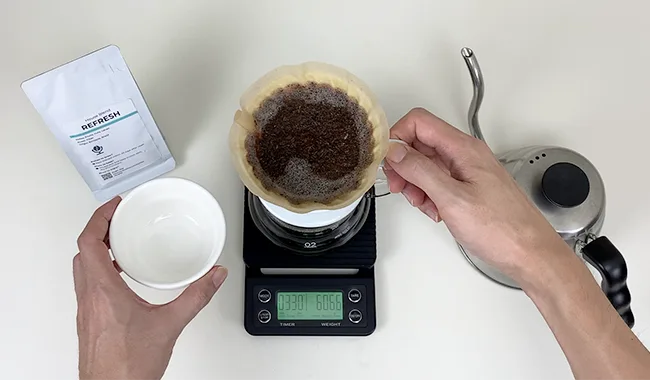
Smell, slurp, enjoy!
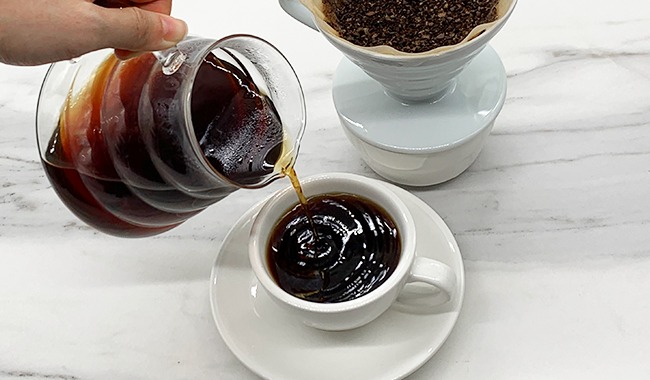
Troubleshooting your V60 4:6 method recipe
V60 brewing issues you may encounter
Sometimes, things just don’t happen the way we want it to. This is true for coffee brewing too!
From our experience, some frustrating issues brewing with V60 4:6 method includes:
- Slow drawdown
- Water clogging towards the end
- Papery taste
- Coffee tastes too intense or too acidic
Fortunately, all these issues are interconnected and can be resolved by slightly adjusting your brewing technique, or changing to a suitable brewing gear — affordably.
In this article, we’ll discuss how to easily troubleshoot your brewing recipe, to make the best V60 coffee.
5 tips to troubleshoot your V60 coffee recipe
1. Check the paper filter you are using
Different brands of paper filter may be made up of different material and pore size, and thus affects the rate of drawdown and taste.
Similarly, even paper filters from the same brand but different model can give varying results.
(a) Packaging and Model: Box vs Plastic Pouch
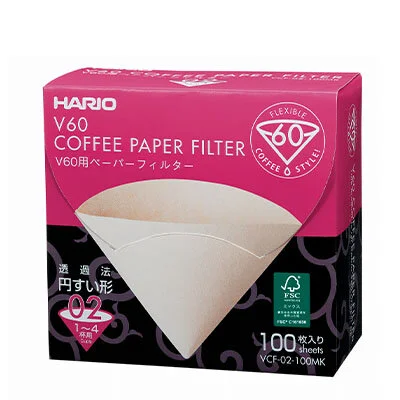
VCF-02-100MK
For example, if you are using Hario paper filter for V60, then you might notice that different Hario packaging and model gives you different drawdown time.
(b) Processing: Unbleached vs Bleached
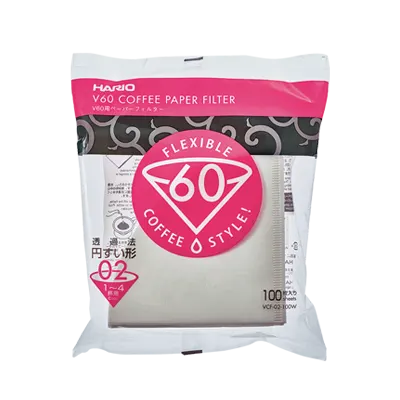
VCF-02-100W
An unbleached paper filter may give you papery notes if not rinsed well, whereas a bleached paper filter, albeit safe to use and gives a shorter drawdown time, may not be so good for our environment.
Because changing your paper filter could drastically affect the whole brewing experience and coffee taste, we recommend that you stick to one brand and one model that you prefer, so that it is easier to adjust other variables.
In our case, we are using the Hario unbleached paper filter, model VCF-02-100M. And we only rinse it once as we preheat our brewing apparatus.
So far, we are happy with it — no papery notes in our coffee, decent drawdown time without clogging issue. Plus, it’s eco-friendly too!
Nevertheless, if you would like to understand a little more about the drawdown time for Hario brand paper filters, we think it will be very useful (also entertaining) to look at the experiment that James Hoffman have done in his video “The Truth About V60 Filter Papers” .
In addition, if you would like to explore scientific analysis of various brands and types of coffee filters, check out the article “An In-Depth Analysis of Coffee Filters” as you sip your coffee.
2. Check the grinder and grind size
Do you find your V60 still clogging at the 4-minute mark?
If this is the case, there are a few reasons for the clogging (assuming you are using the Hario paper filter model VCF-02-100M):
(a) Grind size is too fine for your V60 recipe
Every grinder, even from the same manufacturer and model, can produce slightly different grind size at the same grind setting.
For instance, our recommended grind size 21 on our Baratza Encore could be a 22 to 24 grind size on yours, depending on the alignment as well as wear and tear conditions of the burrs.
Therefore, feel free to explore your grind setting and try a few rounds of brew to dial in.
Based on our experience with our Baratza Encore, a grind size of 19 to 21 usually works well. And following are our brewing observations:
- 20g dose > No water above coffee grounds at 3 min 20s
- 40g dose > No water above coffee grounds at 3 min 30s
- At 3 min 30s, we remove the V60 dripper to sit on another mug for it to continue dripping. At this time, it is common that coffee is still dripping into the mug at this time. And if you would like, have a taste of the remaining drips in this mug, it should taste weak and bitter 🙂
(b) Grinder produces more fines than expected
Sometimes, fines from the previous finer setting are the ones that block the pores of paper filter.
Therefore, if you have changed the grind settings previously, you can try purging with a few grams of coffee (4g to 5g for Baratza Encore).
However, if purging does not work, then it be could be due to alignment or wear and tear condition of the burrs. In this case, you may want to clean your grinder and try brewing again.
In the case of Baratza Encore, you can consider trying the following:
- Firstly, follow the Baratza grinder cleaning instructions to give your grinder a good brush
- After cleaning, test at grind size 22 again to see if there is any improvement in the clogging. How does the coffee taste?
- If it is still clogging, go coarser (e.g., 24) to observe the drawdown and taste.
- How about going finer (e.g., 20) to compare the drawdown and taste?
- Lastly, go back to 22, adjust your pouring to a faster flowrate (i.e., more aggressive pouring). Observe the drawdown to see if is faster. And taste.
Usually for every grind change, we will purge with about 4-5g of coffee beans.
Most importantly, don’t forget to empty the ground container before grinding for your next brew. This clears out any leftover grounds from the previous grind, keeping your coffee fresh and preventing different grind sizes from mixing together.
3. Check coffee dosage and brewing ratio
Comparing 20g vs 40g dose, the 40g dose generally feels a little slower in the drawdown as there are more coffee grounds to work with.
In addition, brewing ratio is the fundamental determinant of the overall taste of your coffee. In the case of V60 4:6 method, we always keep the brew ratio constant at 1:15.
With that, we only adjust sweetness, acidity and strength by the volume for each pour, as well as our pouring style, i.e. hold the kettle lower or higher, control the water flow speed, more aggressive pouring etc.
Of course, if you feel adventurous or just want to try the effect of adjusting brewing ratio, you can increase the brewing ratio, e.g., from 1:15 to 1:16 for a less intense brew, or decrease the brewing ratio e.g., from 1:15 to 1:14 for a stronger brew.
Just a friendly reminder: try changing one variable at a time to avoid getting mixed up along the way. It’ll keep things nice and clear as you experiment!
4. Check your brewing temperature
If you are using filter roast or light-roasted coffee beans, and you are not using a temperature adjustable electric kettle, make sure that you brew with water just off the boil, so that you know you are brewing with water at 94°C and above.
That is because water loses heat really quickly — in a matter of seconds, especially if you in are in an air-conditioned room or brewing in cold weather.
On the other hand, for espresso roast, you can allow hot water to cool for 3 to 5 mins (88°C-92°C) before brewing, depending on the temperature of your surroundings.
So, if you’re brewing in an air-conditioned room or in cold weather, you might find that you only need to wait a minute, or maybe you don’t need to wait at all.
Of course, there is no harm if you want to try brewing your espresso roast with water straight off the boil; your coffee is just going to taste more intense, and you might like it after all!
In short, to get the best result from this V60 recipe, you’ll need HOT enough water. If the water is not hot enough, you might get an under-extracted brew, which can be too acidic.
5. Change your brewing kettle
The Chinese have a saying: “工欲善其事,必先利其器。” It means “To do a good job, one must have an effective tool.”

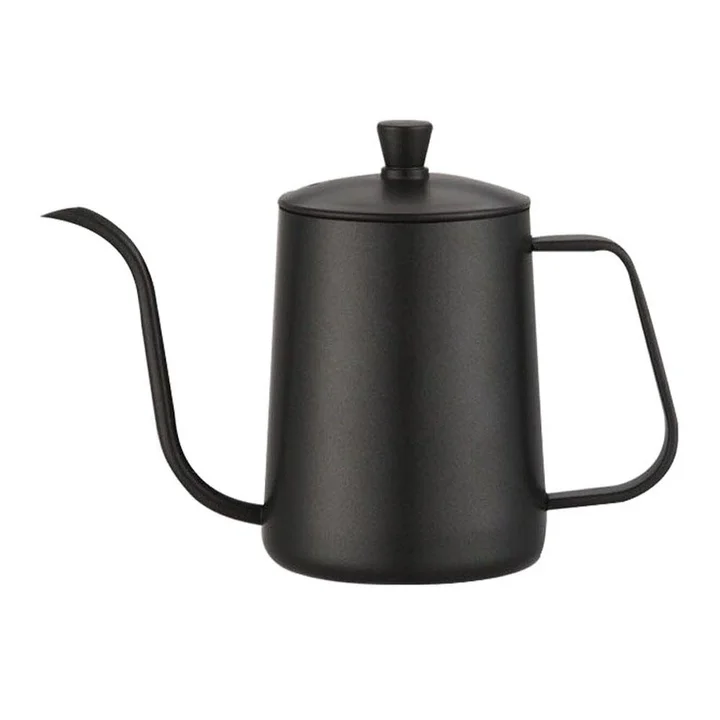
In this case, our daily short spout electric kettle is really not suitable for brewing with 4:6 method, because there’s just no way for us to control the water flow no matter how hard we try.
Similarly, with the pour over gooseneck jug, we find it’s likely more suited for brewing drip-bag coffee. Its unsuitability for V60 brewing could be due to either the narrow size of the spout or the odd angle of the tip.
Due to its unusual design, the gooseneck jug has a slow and limited water flow rate, making it challenging for us to perform more aggressive pouring techniques.
So, we will like to propose that if you really want to make the best V60 coffee, not just for 4:6 method recipe but all other coffee recipes, consider getting a suitable gooseneck kettle.
Not any gooseneck kettle, but a proper one that is designed specifically for pouring versatility and control.
And we’re not going to lie — a good electric gooseneck kettle with temperature adjustment is expensive. But it is a good investment if you are going to use it every day.
If not, the Hario V60 Drip Kettle “Buono” 120 is good enough!
Trial and error with V60 coffee recipe
Lastly, there is no hard and fast rule to brewing the best V60 coffee.
In other words, trial and error is the only way to find the perfect V60 coffee that suits you.
Enjoy and have fun!
Share
Coffee questions?
Connect with us at
Share
Brew better with fresh coffee.
Know what's brewing...!
Join our email list for news, brewing tips and stories to
spice up your coffee experience!
Join our email list for news, brewing tips and stories to spice up your coffee experience!

